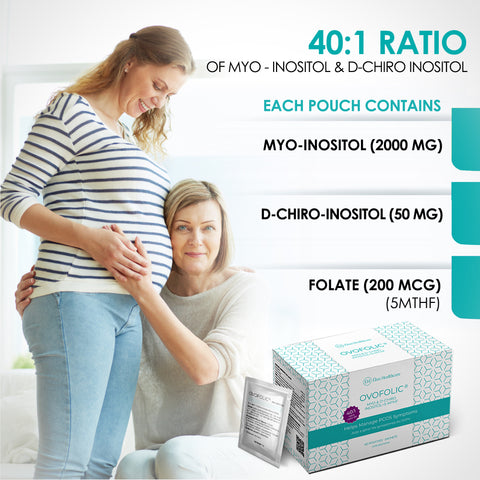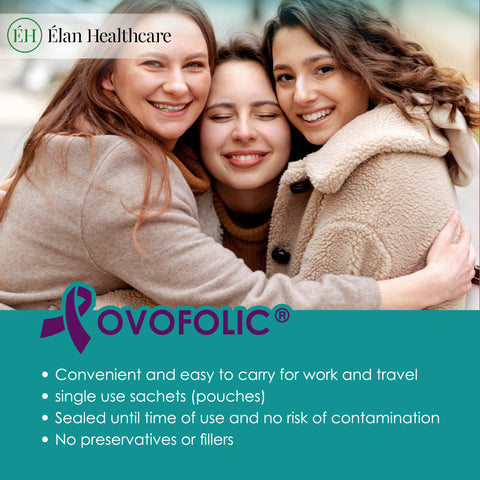Table of contents
Key Takeaways
Introduction
If you're reading this, chances are you're among the millions of women diagnosed with Polycystic Ovary Syndrome (PCOS). PCOS is a hormonal disorder that affects the ovaries and can have various impacts on our bodies and overall health. One aspect that many women with PCOS experience is changes in body shape, particularly what is commonly known as PCOS Belly. This characteristic belly fat distribution is a result of the hormonal imbalances associated with PCOS.
What is PCOS Belly?
First things first, let's demystify the term "PCOS Belly." PCOS Belly refers to the specific pattern of fat distribution in the abdominal area experienced by many women with PCOS. This characteristic fat accumulation is primarily influenced by the hormonal imbalances associated with PCOS, particularly insulin resistance and elevated androgen levels. This stubborn belly fat can be frustrating, but understanding its nature is the first step toward managing it effectively. We have also reviewed several different types of PCOS here, so be sure to check it out before continuing.
A Tale of Three Bellies - PCOS, Hormonal, and Normal
It's important to distinguish PCOS Belly from other types of belly fat. Let's compare them to gain a clearer understanding -
- PCOS Belly - This type of belly fat is unique to women with PCOS. It typically manifests as excess fat accumulation in the lower abdomen, creating appearance. The underlying hormonal imbalances, such as insulin resistance and elevated androgens, contribute to the development of the PCOS stomach.
- Hormonal Belly - Hormonal belly, also known as hormonal weight gain, can occur in women due to various hormonal fluctuations, including during pregnancy or menopause. It is characterized by overall weight gain and fat distribution across the abdomen, hips, and thighs. Unlike PCOS lower belly fat, hormonal belly is often temporary and resolves with hormonal stability.
- Normal Belly Fat - This is the regular belly fat that can occur in individuals regardless of their hormonal profile. It is influenced by factors such as genetics, overall body fat percentage, and lifestyle habits. Normal belly fat can be distributed differently among individuals and may not exhibit the specific characteristics of the PCOS stomach.
It’s also not uncommon to link PCOS belly to Endometriosis, so if you’re having doubts about the origin of your belly, take a look at our article Endometriosis vs PCOS: What Is The Difference Between The Two? highlighting the key differences. Understanding these distinctions between PCOS belly, hormonal belly, and normal belly fat allows us to appreciate the specific challenges associated with PCOS and the need for tailored strategies to manage and reduce PCOS belly effectively.
What Does a PCOS Belly Look Like?
When it comes to the PCOS tummy, it's essential to understand its distinctive shape and characteristics. It is often characterized by excess fat accumulation in the lower abdomen, resulting in a rounder or "apple-shaped" appearance. It tends to exhibit the following features:
- Central Fat Distribution - The excess fat tends to be concentrated around the abdomen, specifically in the lower area.
- Visceral Fat - PCOS Belly often includes visceral fat, which surrounds the organs within the abdominal cavity.
- Increased Waist Circumference - Women with PCOS may notice an increase in their waist circumference due to the accumulation of fat in the abdominal region.
While PCOS Belly and a pregnant belly may share some visual similarities, there are notable distinctions between the two. The PCOS stomach typically distributes fat in the lower abdomen, while a pregnant belly expands uniformly as the baby grows. The nature of the bellies is different, of course - PCOS belly consists of excess fat, while a pregnant belly contains a developing fetus. And, we always have to take into account the hormonal factors - PCOS tummy fat is primarily influenced by hormonal imbalances associated with PCOS, while a pregnant belly is a natural result of the physiological changes during pregnancy.
Understanding the Causes of PCOS Belly
Several factors contribute to the development of PCOS belly bloat and belly fat:
- Insulin Resistance - Insulin resistance, common in PCOS, leads to increased insulin production, which can promote fat storage in the abdominal area.
- Androgen Levels - Elevated androgen levels, such as testosterone, can contribute to fat accumulation in the abdominal region.
- Inflammation - Chronic inflammation associated with PCOS may further contribute to belly bloating and fat deposition.
Effects of Hormone Imbalance on PCOS Belly
The hormone imbalance characteristic of PCOS can have specific effects on the increased fat storage and difficulty losing fat in the belly area. Hormonal imbalances, including insulin resistance and elevated androgens, can promote fat storage in the abdominal region. As mentioned earlier, PCOS Belly fat is often stubborn and challenging to lose due to hormonal influences and metabolic factors. As we’re on the topic of hormone imbalances, you may want to find out more about managing them and promoting regular periods with PCOS. If so, be sure to check out our article How to Have Regular Periods with PCOS. It delves deeper into this topic and provides valuable guidance to help you navigate the complexities of PCOS, striving for hormonal balance and improved overall well-being.
How to Get Rid of Hormonal Belly with PCOS
Although there is no universal approach, a combination of dietary and lifestyle modifications can yield remarkable results. Here are some actionable tips:
1. Nourish Your Body
- Embrace a PCOS-friendly Diet - Focus on whole foods, high in fiber, lean proteins, and healthy fats. Minimize processed foods, refined sugars, and excessive carbohydrates.
- Balance Your Meals - Aim for a balance of macronutrients (carbohydrates, proteins, and fats) to stabilize blood sugar levels and prevent insulin spikes. Take a look at our suggestions for healthy breakfast ideas to help treat PCOS: Top 5 Breakfast Ideas For PCOS.
- Watch Your Portions - Be mindful of portion sizes to avoid overeating and promote weight management.
- Stay Hydrated - Drinking plenty of water helps with digestion, reduces bloating, and supports overall well-being.
2. Engage in Physical Activity
Best Exercises for PCOS Belly Fat - When it comes to reducing PCOS (Polycystic Ovary Syndrome) belly fat, incorporating a combination of cardiovascular exercises, strength training, and mindful practices can be highly beneficial.
- Cardiovascular exercises like brisk walking, running, cycling, or swimming help burn calories and promote overall fat loss, including the belly region.
- Strength training exercises, such as weightlifting or bodyweight exercises, increase muscle mass, boost metabolism, and aid in fat burning. Targeting the core muscles with exercises like planks, crunches, or Russian twists can help strengthen the abdominal muscles and tone the belly.
- Additionally, practicing mindfulness activities like yoga or Pilates can reduce stress levels, which is essential for managing PCOS symptoms and preventing weight gain.
Remember, consistency and a balanced approach to exercise, along with a healthy diet, are key factors in achieving long-term success in reducing PCOS belly fat.
3. Seek Professional Guidance
- Consult a Registered Dietitian - They can help create a personalized meal plan and guide you in making healthy food choices.
- Talk to Your Doctor - If lifestyle changes alone don't yield desired results, your doctor may discuss the potential benefits of medications like metformin for PCOS belly fat reduction.
In treating your PCOS belly, you might come in contact with various symptoms, side effects and treatments. We have reviewed most of them in our article: Dealing with PCOS: Symptoms, Side Effects, and Treatments.
The Role of Metformin in PCOS Belly Fat Reduction
Metformin is an oral medication commonly prescribed for individuals with PCOS, primarily to address insulin resistance. Metformin improved Insulin sensitivity and affects androgen levels and with that, can have positive effects on PCOS-related weight management, including belly fat reduction. In a Meta-Analysis of 12 clinical trials, it was shown that in all studies, overweight women with polycystic ovary syndrome treated with metformin had significantly improved endocrine and metabolic indicators and as such, metformin appears to be an effective intervention for overweight women with PCOS.
The Role of Inositol in PCOS Belly Fat Reduction
Inositol has been gaining attention for its potential role in reducing belly fat associated with polycystic ovary syndrome (PCOS). Inositol combinations such as Ovofolic have been shown to improve insulin sensitivity, regulate hormone levels, and promote healthy ovarian function in women with PCOS. By positively influencing insulin signaling and metabolism, inositol may contribute to a reduction in belly fat accumulation. While more studies are needed to fully understand the mechanisms and optimal dosage of inositol for PCOS belly reduction, it holds promise as a potential natural intervention in managing this aspect of the condition.
Conclusion
Managing PCOS belly is undoubtedly a challenge, but by understanding the nature of PCOS belly, making informed dietary and lifestyle choices, and seeking professional guidance when needed, we can effectively manage this aspect of PCOS.
The journey to a healthier body and mind is unique for each of us. Embrace the progress you make, no matter how small, and be patient with yourself.
Disclaimer - This article is for informational purposes only and does not constitute medical advice. Please consult with your healthcare professional before making any significant changes to your diet or exercise routine.

























No comments yet.
There are no comments for this article. Be the first one to leave a message!
+ Open to leave a Comment